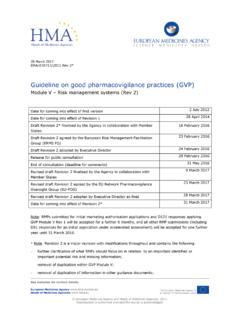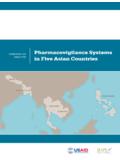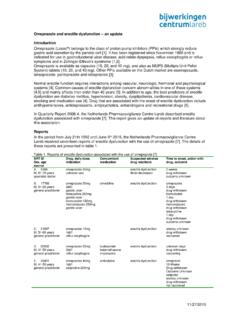Transcription of Guideline on good pharmacovigilance practices (GVP)
1 See websites for contact details European Medicines Agency Heads of Medicines Agencies The European Medicines Agency is an agency of the European Union European Medicines Agency and Heads of Medicines Agencies, 2017. Reproduction is authorised provided the source is acknowledged. 9 October 2017 EMA/813938/2011 Rev 3* Guideline on good pharmacovigilance practices (GVP) Module VIII Post-authorisation safety studies (Rev 3) Date for coming into effect of first version 2 July 2012 Date for coming into effect of Revision 1 25 April 2013 Date for coming into effect of Revision 2 9 August 2016 Revised draft Revision 3* finalised by the Agency in collaboration with Member States 27 September 2017 Revised draft Revision 3 agreed by the EU Network pharmacovigilance Oversight Group (EU-POG)
2 4 October 2017 Revised draft Revision 3 adopted by Executive Director as final 9 October 2017 Date for coming into effect of Revision 3* 13 October 2017 *Note: Revision 3 contains the following: - Updates in (study protocol section 11), and (final study report section ), in order to align this Module with revision 2 of GVP Module VI. This revision of the Module was not subject to public consultation because it concerns amendments with the specific objective to align its content with the changes in GVP Module VI Revision 2, which was subject to public consultation. Guideline on good pharmacovigilance practices (GVP) Module VIII (Rev 3) EMA/813938/2011 Rev 3 Page 2/28 Table of contents Introduction.
3 4 Terminology .. 5 Structures and processes .. 6 Principles .. 6 Study registration .. 7 Study protocol .. 8 Format and content of the study protocol .. 9 Substantial amendments to the study protocol .. 12 Reporting of pharmacovigilance data to competent authorities .. 12 Data relevant to the risk-benefit balance of the product .. 12 Reporting of adverse reactions/adverse events .. 12 Study reports .. 13 Progress report and interim report of study results .. 13 Final study report .. 13 Publication of study results .. 17 Submission of manuscripts accepted for publication .. 17 Data protection.
4 17 Quality systems, audits and inspections .. 17 Impact on the risk management system .. 17 Operation of the EU network .. 18 Procedure for imposing post-authorisation safety studies .. 18 Request for a post-authorisation safety study as part of the initial marketing authorisation application .. 18 Request for a post-authorisation safety study during a post-authorisation regulatory procedure .. 18 Request for a post-authorisation safety study due to an emerging safety concern .. 18 Joint post-authorisation safety studies .. 18 Written observations in response to the imposition of an obligation.
5 19 Supervision of non-interventional post-authorisation safety studies conducted pursuant to an obligation .. 19 Roles and responsibilities of the marketing authorisation holder .. 19 Roles and responsibilities of the PRAC and the national competent authority .. 20 Roles and responsibilities of the Agency .. 21 Changes to the marketing authorisation following results from a non-interventional post-authorisation safety 21 VIII. Appendix 1. Methods for post-authorisation safety studies .. 23 Study designs .. 23 Active surveillance .. 23 Intensive monitoring schemes .. 23 Prescription event monitoring.
6 24 Registries .. 24 Observational studies .. 25 Guideline on good pharmacovigilance practices (GVP) Module VIII (Rev 3) EMA/813938/2011 Rev 3 Page 3/28 Cross-sectional study .. 25 Cohort Study .. 25 Case-control study .. 25 Case-only designs .. 26 Clinical trials .. 26 Large simple trials .. 27 Drug utilisation studies .. 27 Data sources .. 27 Guideline on good pharmacovigilance practices (GVP) Module VIII (Rev 3) EMA/813938/2011 Rev 3 Page 4/28 Introduction Regulation (EC) No 726/2004, Directive 2001/83/EC and Commission Implementing Regulation (EU) No 520/2012 (hereinafter referred to as REG, DIR and IR) include provisions for post-authorisation safety studies applicable in the European Union (EU).
7 A post-authorisation safety study (PASS) is defined in DIR Art 1(15) as any study relating to an authorised medicinal product conducted with the aim of identifying, characterising or quantifying a safety hazard, confirming the safety profile of the medicinal product, or of measuring the effectiveness of risk management measures. A PASS may be interventional or non-interventional. This Module concerns both interventional and non-interventional PASS, with a main focus on non-interventional ones. It does not concern pre-clinical safety studies. Non-interventional PASS concerned by this guidance are those initiated, managed or financed by a marketing authorisation holder voluntarily or pursuant to an obligation imposed by an EU competent authority [DIR Art 107m(1), REG Art 28b].
8 Non-interventional PASS concerned can be: imposed as an obligation in accordance with REG Art 9(4)(cb) and Art 10a(1)(a) and with DIR Art 21a(b) and Art 22a(1)(a) (category 1 of studies in GVP Module V); imposed as a specific obligation in the framework of a marketing authorisation granted under exceptional circumstances (category 2 of studies in GVP Module V); required in the risk management plan (RMP) to investigate a safety concern or to evaluate the effectiveness of risk minimisation activities (category 3 of studies in GVP Module V); or conducted voluntarily by a marketing authorisation holder.
9 Non-interventional PASS shall be conducted in accordance with the following provisions: DIR Art 107m for non-interventional PASS initiated, managed or financed by a marketing authorisation holder voluntarily or pursuant to imposed obligations; DIR Art 107n-q, REG Art 28b and IR Art 36-38 for non-interventional PASS conducted pursuant to an obligation imposed by an EU competent authority (categories 1 and 2 of studies in GVP Module V). A PASS is non-interventional if the following requirements are cumulatively fulfilled (see Volume 10 of The Rules Governing Medicinal Products in the European Union, Questions and Answers, Version , 15 May 2013, Question )1: the medicinal product is prescribed in the usual manner in accordance with the terms of the marketing authorisation; the assignment of the patient to a particular therapeutic strategy is not decided in advance by a trial protocol but falls within current practice and the prescription of the medicine is clearly separated from the decision to include the patient in the study.
10 And no additional diagnostic or monitoring procedures are applied to the patients and epidemiological methods are used for the analysis of collected data. 1 Guideline on good pharmacovigilance practices (GVP) Module VIII (Rev 3) EMA/813938/2011 Rev 3 Page 5/28 Non-interventional studies are defined by the methodological approach used and not by its scientific objectives. Non-interventional studies include database research or review of records where all the events of interest have already happened (this may include case-control, cross-sectional, cohort or other study designs making secondary use of data).












